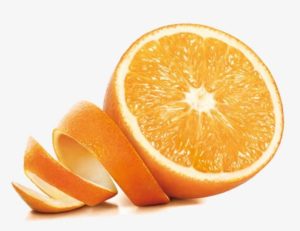
Orange
Citrus aurantium (bitter) or Sinensis (sweet) is a spherical tree that belongs to the family Rutaceae. The orange tree does not exceed 8 to 10 m high and is the most cultivated citrus in the world.
The sweet orange tree is undoubtedly a mutation of the bitter orange which occurred about 2000 years ago. In China and India, the bitter orange was already cultivated 3000 years ago. The foot of the Himalayas, around Bangladesh, is undoubtedly the place of origin of this citrus fruit.
For instance, Greeks, Romans … Nobody knew the sweet orange tree. It was the Arabs who introduced it to Egypt and Palestine, where the Crusaders discovered it. For example, the Portuguese made the orange tree a great success, bringing it back from China or Ceylon (Sri Lanka) around 1500.
Sweet orange is one of the most popular fruits in the world. For instance, today we can all enjoy a good orange juice at breakfast, until the late nineteenth century, this fruit was a luxury.

With sweet orange, we make refreshing and tart syrups and a lemonade: orangeade.
Flowers and leaves of sweet orange: they have the same virtues as those of bitter orange trees.
Health benefits
The leaves of the bitter orange are used for its sedative properties: they soothe the spasms of nervous people and allow them to fall asleep. Also, recommended for quenching coughs, nervous stomach cramps, palpitations, cephalalgia (headaches). It is also sometimes used as a febrifuge and sudorific (which increases perspiration) in case of colds.
Also, the blossom can be used for the same purposes, but in general, it is used in the preparation of “orange blossom water”, very fragrant and used in pharmacy and food.
The essential oil that accompanies the hydrolat during the distillation is “neroli oil”, the base of quality colognes. It is known for its rarity, its invigorating and distressing character.

Likewise, zest is recommended in case of problems related to the fragility of small blood vessels, such as bruising. People who are bedridden or operated often have pain in their heels. In this case, it is recommended to cut an orange in half, to empty each half and to fit the heels.
Internal use; preparation tips
Infusion: 20 g of flowers or leaves per liter of water. Let infuse 10 minutes. Consume 2 to 3 cups a day, including 1 at bedtime to help fall asleep. To accentuate the fragrance and the effect, do not hesitate to add a few drops of orange blossom water.
A decoction of leaves: 120 to 150 leaves per liter. It was once used for epilepsy and in case of serious nerve disturbances.
Bitter orange peel syrup: this syrup is tonic and stomachic. Preparation: 100 g of dry zest cut into pieces and macerated for 12 hours with 100 g of alcohol at 60% vol. Pass and add a syrup prepared with 350 g of sugar in 1 l of water.
Orange wine aperitif and tonic: macerate 100 g of bitter orange zest in 1 l of white wine with some chamomile flowers.
External use
Infusion of flowers and orange leaves: calm and softens the skin.
Growing tips
Above all, to grow the orange tree, a neutral pH soil will be ideal. Most importantly, choose a clay soil that retains water and fertilizer but not excess moisture. Regarding the exhibition …
The trunk can withstand – 9 ° C, its foliage is damaged from – 3 ° C. Between 0 and 10 ° C, the orange tree is in a vegetative state. Certainly, to flower and give fruit, it must grow in areas where the average annual temperature exceeds 13 ° C.
Whether you choose to grow in pots or in the ground, do not scratch the ground on more than 5 cm of depth when weeding, so as not to damage the superficial roots. They are fragile and each wound can open the door to an illness … Be aware however that only a conservatory or a cold greenhouse can keep it in winter without problems.

Nutritional fact
45 k cal / 100 g. It covers most of the daily needs of an adult vitamin C (80 to 110 mg/day). Also it’s rich in trace elements and organic acids, which combine with the alkaline substances of our body, producing carbonates and bicarbonates, whose benefits are recognized in cases of heartburn and arthritis. It’s time to let yourself be tempted by a carpaccio of oranges. Fast, easy, this recipe is unbreakable!
